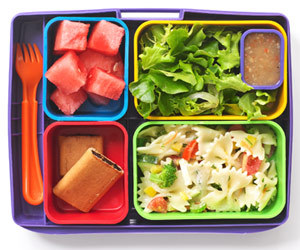
When most of us think of school lunch, we think mystery meat, soggy pizza, sloppy joes, and a complete absence of fruits and veggies. Thanks to the USDA’s new school meal requirements released last month, the lackluster and nutritionally devoid school lunches of the past are facing some major improvements. In the near future, you can now feel more confident knowing that the meals your child consumes at school will be well-balanced and include plenty of high-fiber, low-salt, low-sugar, and low-fat choices.
Initiated by Michelle Obama’s “Let’s Move!” campaign and the sharp increase in childhood obesity, the main goal of the new meal requirements is to encourage the same kinds of healthy and practical changes at school that many parents are hard at work modeling at home. The offerings will include a variety of fruits and vegetables each day, more whole grains, and calorie levels and portion sizes to maintain a healthy weight. The key changes for children in kindergarten through 12th grade include:
1. A daily serving of fruit at breakfast and lunch. Students can choose from fresh fruit, frozen fruit without added sugar, canned fruit in 100 percent juice or light syrup, or dried fruit.
2. A daily serving of vegetables that promotes variety over the course of the week. Options include fresh, frozen, or lower-sodium canned vegetables. Weekly requirements for vegetables include dark green vegetables, red or orange vegetables, beans and peas, and starchy and other vegetables. Vegetable consumption must total 3 to 5 cups per week, depending on the age of the student.
3. Increased offerings of whole-grain-rich foods, which must contain at least 51 percent whole grains. Whole grain foods include whole wheat bread, brown rice, oatmeal, and whole grain pasta. Whole grains are set to be phased in so that by July 2014, all grains offered at both breakfast and lunch will be whole grain.
4. A variety of chicken, meat, fish, and protein alternatives will be given, including nut butters, eggs, tofu, and soy or milk-based yogurt. Weekly ranges for protein-containing foods will be set in ounces according to grade level.
5. Only fat-free (flavored and unflavored) and low-fat (unflavored) milk will be offered at breakfast and lunch
6. New sodium restrictions will be phased in over a 10 year period.
7. Trans fat restriction will be set at zero grams per serving and saturated fat will be set at less than 10 percent of total calories.
8. Calorie minimum and maximum levels will be set for grade level ranges.
Information about your child’s school meal menu should be available through the school district’s website. For tons of tips on feeding your family the healthy way both at school and at home, head over to the Academy of Nutrition and Dietetic’s website at www.eatright.org. Need more help? That’s where Family Food, LLC comes in! Give us a call, shoot us an e-mail, or leave us a message on Facebook or Twitter. Your insurance may entitle you to SIX FREE VISITS – head over to our Services page to learn more!
Source: http://www.elpasotimes.com/living/ci_20202494/judy-estrada-coming-soon-school-cafeteria-less-fat

